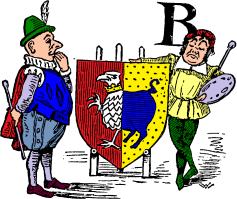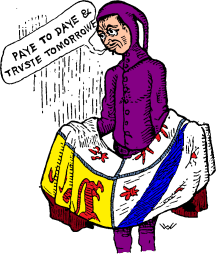HOME
Preface
Introduction
1
2
3
4
5
6
7
8
9
10
11
12
13
14
15
16
17
18
19
20
21
22
23
XX
CHAPTER XX.
MARSHALLING ARMS.
Y Marshalling Arms is meant the art of putting two or more sets of these useful appendages to a gentleman's Heraldic wardrobe into one escutcheon, which might lead people to imagine that Heraldic coats were made of some elastic material, with a capacity for stretching unequalled in any other known fabric.
Such, however, was not the case. The coats were not stretched, but the arms were diminished and made to fit, making the pattern on the shield, where the operation was performed by "dimidiation" (a kind of Heraldic half-and-half) distinct from the entire of a coat, and displaying only one set of cognizances.
"Dimidiation" was the most ancient style of marshalling, and possessed the extraordinary merit of simplicity. It was effected by chopping both coats in two, and sticking half one on to the half of the other, and vice versa. What was done with the bits over we are not told; probably the Heralds regarded them in the light of legitimate "cabbage" and took them home to their wives, and mended their own tabards with them when those official garments required repair.
Of course, as might be expected, the dimidiated halves never matched, and presented to the spectator an incongruous, not to say ridiculous, appearance. Thus, supposing the cognizance on the first coat to have been--"Arg., a good templar proper" (or sober), and on the second "Or, a licensed victualler inebriant, beaked gules," half the cognizance would appear to be sober and the other half in a state of inebriety, which would naturally offend the susceptibilities of both families.
This plan was therefore not found to work well in practice; the Heralds, who were nothing if not inventive, determined to discard it in favour of "impalement."
The first idea as regards "impalement" is that it has some connection with a stake and the early Turkish prescription for the cure of Mohammedan perverts when caught, and that the Heralds, with that dry humour for which they were so famous, stuck at the perpetration of no monstrosity for the advancement of their doctrines. But this idea, like a good many others in connection with Heraldry, would be utterly wrong.
Impalement, in Heraldry, is performed by compressing two coats of arms and placing them side by side in one escutcheon, a fine line dividing them per pale. Thus, for instance, would be blazoned the arms of a husband and wife, just as in common life you may see woman and her victim, or "Baron" and "femme," as those funny wags Garter & Co. would persist in calling them, coming home from the family pew every Sunday morning.
As in the Latin grammar, so here, the masculine is, erroneously, say the shrieking sisterhood, more worthy than the feminine, and consequently the arms of the husband occupy the dexter half of the shield, those of the wife taking the sinister side, or what is left.
Should, however, the lady be an heiress--an excellent quality in woman--her legal proprietor and worse half would not impale her arms, but would impose her armorial bearings upon his own coat, charged upon an escutcheon or "shield of pretence," thereby delicately intimating to the general public that she, having given him her hand, he pretends to or wants to get hold of the rest of her goods and chattels. Where the marriage settlements are not tight, and the husband is loose, this pretence becomes a reality.
The children of an heiress take the hereditary coats of arms of their father and mother quarterly, just as landlords do their rents ; which implies a fixed inheritance, a capital institution, and one specially to be recommended to all young persons starting in life. In these coats the first and fourth quarters contain the arms of the father, and the second and third those of the mother--another instance of man's injustice to woman, the first-named quarters being the most honourable.
To return, however, to the general run of wives who are not heiresses, except to the natural estate of sin and wickedness which we all inherit, and upon which, as a rule, no money is to be raised. If from railway accidents, doctors, or other misfortunes, the lady should retire from this life, and the disconsolate widower takes another dip in the matrimonial lucky-bag, the first wife's arms will stand on the chief (which suggests to the pensive student something of an acrobatic performance with the Bounding Brothers of the Desert), and those of the second on the base. Or the shield may be divided in tierce, that is, in three equal divisions in pale (this has a domestic smack about it, as the little boy said when his mother spanked him), the first wife's coat, or should we say petticoat? next to the husband's, and those of the second outermost.
Supposing, however, we have to deal with a man of such reckless hardihood and love of adventure, one who has the extraordinary boldness to plunge for a third time into matrimony, the arms of his two first speculations shall stand on the chief (acrobatic performances again, only more so), and the third on the base. Nay, Heralds even provided (Heraldically) for the positively awful contingency of a fourth wife, and ordained that her arms must participate in one-half of the base with defunct number three; and thus the armorial bearings of the various spouses will appear on the escutcheon of the husband as so many coats quartered, for it stands to reason that a man who thus often indulges in so many better-halves connubially must be content with quarters Heraldically.
Further than that Garter and his friends declined to go. Four wives in a lifetime they considered enough for any man, and the domestic relations of a Bluebeard [N.B.--A much misunderstood victim of marital love of perfection] were not recognized by the College.
Should a man, like the illustrious Mr. Weller, sen., marry a widow, he is not allowed, while adopting the rib of the deceased's husband, to take his arms with the other baggage, but only those borne by the wife as a single woman.
If a maiden or dowager lady of rank marry a commoner person than herself, their coats of arms are not impaled, but are placed side by side in two separate escutcheons upon one mantle or drapery, the lady's arms ornamented according to her title. As usual, lovely woman gets the worst of it, and goes to the left.
Kings-at-Arms and bishops impale their private with their official arms, the latter occupying the dexter side. Thus, in a prelate it would seem to intimate that though as a man he may be a success, yet as a bishop he is a successor, as he undoubtedly is to the former occupant of the See.
The arms of a bachelor, with the exception of the before-mentioned officials, consist of a single Heraldic coat, never of two coats impaled. Bachelors, however, may have any quantity of other coats, waistcoats, trou--, sundry habiliments, provided they have money to pay for them, or can find a confiding tailor to trust them. Equally is this the case with unmarried ladies, both armorially and sartorially, substituting milliners for tailors.
[N.B.--The Heralds never gave trust.]
XX
1
2
3
4
5
6
7
8
9
10
11
12
13
14
15
16
17
18
19
20
21
22
23
Preface
Introduction
HOME
Build: 2019/04/20 14:20:08.59+0900(JST)



